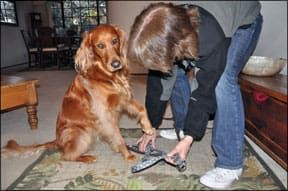You contemplate taking your dog for a walk with mixed emotions. You love the idea of going for a companionable stroll through the neighborhood together, but it’s a major hassle to get out the door. When you pick up his leash he becomes the Tasmanian Devil – body slamming you, racing around the foyer, and bouncing off the plate glass door with such intensity you’re afraid he’ll crash right through it. Here are five suggestions for turning this potential disaster into the enjoyable outing you dream of.
1. Exercise before your walk.
Spend 15-20 minutes tossing a ball for your dog in the backyard, playing “Run upstairs to get a treat from the Manners Minder,” or providing intense mental exercise with a heavy duty shaping session (see “Fun Dog Training Techniques Using Shaping!,” March 2006). You’ll take the edge off his excitement, reduce his energy level, and make leashing-up and walking more relaxed and enjoyable for both of you.
2. Teach your dog to “Say please.”
Reinforce your dog’s “sit” behavior so thoroughly that “sit” becomes his default behavior – the behavior he chooses to offer when he doesn’t know what else to do. Then wait for him to sit (say “please”) to make all good things happen: sit for his dinner bowl; sit to be petted; sit for you to throw his ball; sit to have his leash put on; and sit to make the door open.
3. Pick up his leash throughout the day.
He gets amped up when you touch his leash because it always means the two of you are going for a walk. Of course he gets excited! If you pick up his leash numerous times throughout the day, sometimes draping it over your neck and wearing it for a while, sometimes carrying it from room to room, sometimes picking it up and putting it back down, sometimes clipping it on his collar and then unclipping it, the leash will no longer be a reliable predictor of walks, and he won’t have any reason to get all excited about it. Note: This will take a while. Hope springs eternal in the canine heart.
4. Use negative punishment.
No, that’s not a bonk on the head. It means setting up the situation so that doing the behavior you don’t want causes a good thing to go away. Here’s how it would work in this case: If, when you pick up the leash, he goes bonkers (the behavior you don’t want), say “Oops!” in a cheerful tone of voice (what’s known as a “no reward marker,” it simply tells him no reward is forthcoming), set the leash down, and walk away. When he settles down, pick the leash up again. If he sits (say please!), proceed with attaching the leash and going for a walk. If he winds up again, do another “Oops!” and set the leash down. You’re teaching him that getting excited makes the opportunity for a walk go away; staying calm makes walks happen.
5. Reduce the significance of other “walk cues.”
Other things you do as part of your walk preparation routine can also feed his energy – getting out treats, putting on your jacket, grabbing your cell phone and keys . . . The more you randomize your ritual, the less these steps contribute to his growing excitement over the pending event, and the calmer he’ll stay as you leash him and walk out the door. For example, put your keys and cell phone in your jacket pocket before you eat breakfast. Happy walking!
Pat Miller, CBCC-KA, CPDT-KA, is Whole Dog Journal’s Training Editor.





